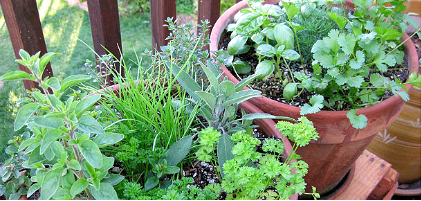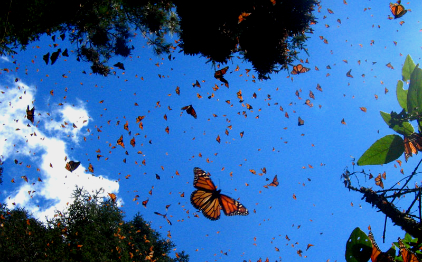by Chris Winslow
Though the fortunes of the monarchs rise and fall from year to year,
when you look beyond the latest statistics and look back to the num-
bers recorded 20 years ago, then you realize how steep the overall
decline has been.
As gardeners, and as stewards of our lands, I believe we should all
put aside some part of our gardens to be good hosts to our magical
visitors on their epic 2,800 mile journeys back and forth between
Michoacan in Mexico and Canada. (Photo above from the Patzcuaro
area in Mexico.)
To do this we just have to choose the right plants to support the butt-
erflies during their larva (caterpillar) stage.
-
For monarchs, try planting butterfly weed (Asclepias tuberose). This
tropical milkweed grows to a height of 2 to 4 feet, and has striking
orange and red flowers.
Besides being a host plant, milkweed also has an abundance of nec-
tar. Nectar plants act as fueling stations or pit stops for many differ-
ent species.
Other great nectar plants commonly found in our central Texas gar-
dens are lantanas, butterfly bushes (Buddlea), pentas, mistflowers
(Eupatoriums), mealy sages, Turk’s caps, and wild bergamot.
There are other types of butterflies that we can attract to our yard
through careful choice of plants.
For black swallowtail butterflies, I offer my triple curled parsley,
which will reach a height of two and a half feet in May, and will
have hundreds of beautiful blooms. The caterpillars will then get
busy eating the foliage. (Other hosts for black swallowtails are dill,
fennel, and rue.)
The list of host and nectar plants is lengthy and includes many nat-
ive and adaptive species that thrive in our region with little care.
Gulf fritillaries and zebra longwings have a passion for passionvine,
for example. Red admirals like pellitory, and for tiger swallowtails,
it's Texas ash.
Many of these plants add beauty to our landscapes and are tolerant
of drought. For more detailed information, a visit the Austin Butter-
fly Forum website (austinbutterflies.org) would be a good idea.
Why not add a few of these drought-hardy species to your garden
and be a good Lepidopteral host to these marvels of nature . . . and
if we can all provide more milkweed for the monarchs, we should
be able to continue to support and increase the number taking part
in these epic migrations. Happy butterfly gardening everyone!






